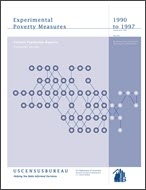
An official website of the United States government
Here’s how you know
Official websites use .gov
A .gov website belongs to an official government organization in the United States.
Secure .gov websites use HTTPS
A lock (
) or https:// means you’ve safely connected to the .gov website. Share sensitive information only on official, secure websites.
-
//
- Census.gov /
- Publications /
- Experimental Poverty Measures: 1990 to 1997
Experimental Poverty Measures: 1990 to 1997
Experimental Poverty Measures: 1990 to 1997
Executive Summary
This report presents experimental measures of poverty in the United States. These measures are illustrative variations of the recommendations of the Panel on Poverty and Family Assistance: Concepts, Information Needs, and Measurement Methods of the National Research Council.1 The experimental measures presented here:
- Incorporate, in a way that the official measure does not, the effects of key government policies aimed at the most needy families in the United States.
- Use an after-tax income measure.
- Add the value of in-kind benefits, such as food stamps, to income.
- Take account of variations in expenses that are necessary to hold a job or to obtain medical care.
Key Findings
- Considering all in-kind transfers together reduces the incidence of poverty substantially, even though the reductions from any single program are generally quite small.
- The increase in poverty rates when one accounts for necessary expenses can be substantial but depends on the method used to value those expenses.
- Because of the earned income credit, deducting taxes from income on balance reduces the percentage of people who are viewed as being poor.
__________
1 Citro, Constance F. and Robert T. Michael (eds.), Measuring Poverty: A New Approach, Washington, DC: National Academy Press, 1995.
Others in Series
Publication
Visualization
Publication
Share
Related Information
Some content on this site is available in several different electronic formats. Some of the files may require a plug-in or additional software to view.
 Yes
Yes
 No
NoComments or suggestions?


Top


